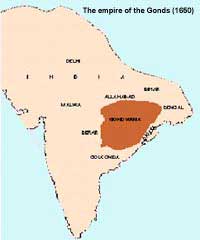Legacy of an empire
 gondwanaland: supercontinent in geological history, of which India was a part. Gondwana ('Forest of the Gonds'): land of the Gond tribals and their powerful empire. A historic region which straddles the four states of Madhya Pradesh, Maharashtra, Andhra Pradesh and Orissa. And famed for its traditional water harvesting structures.
gondwanaland: supercontinent in geological history, of which India was a part. Gondwana ('Forest of the Gonds'): land of the Gond tribals and their powerful empire. A historic region which straddles the four states of Madhya Pradesh, Maharashtra, Andhra Pradesh and Orissa. And famed for its traditional water harvesting structures.
However, most of these systems are lying defunct and derelict today, as examples from western Orissa show. The 60-hectare (ha) Rani Sagar in Bijepur village of Sambalpur district is a case in point. Built by Gond zamindar (landlord) Damodar Gadotiya in 1821 to harvest rainwater for irrigation, this huge water body (locally known as a kata) is heavily silted and full of weeds today. Tulsi Prasad Gadatia, a former zamindar of Bijepur, claims the descendants of Damodar "had been responsible for the kata's repair and maintenance and the distribution of its water until the abolition of zamindari," after which the state-and its apathy-took over.
Katas are three-sided reservoirs, with one side kept open to recieve runoff water. Notes Nirmal Sengupta, a professor at the Madras Institute of Development Studies, "Unlike regular tanks, these are not dug out but consist of elevated embankments over the surface and thus facilitate gravity flow instead of requiring lifting for irrigation." Despite Bijepur's flat topography, the Gonds, known for their traditional wisdom in building katas by astutely judging the flow of rainwater, constructed a kilometre-long embankment with a catchment area of 200 ha; this catchment area stands reduced to less than half its original size today.
Kata culture
The zamindars, who doubled as village headpersons called gountias, built thousands of such katas and other types of water harvesting systems on lands gifted by Gond kings. Elaborate rules were formulated by gram sabhas - village councils - to govern these katas; gountias implemented the rules. Cattle were not allowed to enter the path leading to a kata during monsoons. About one ha of land around the edges of each kata was left untouched; side channels around the katas enabled the outflow of excess water, thus reducing waterlogging in the fields.
Also, systematic release of water provided timely irrigation to all fields situated in the kata's command area. "A kind of pani-panchayat (water council) was responsible for the proportional release of water. The land that grew 90-day paddy would get the water first, then the one with the 110-day variety and finally the land with 130-day paddy," says Gadatia.
Repair and maintenance work was normally done once in three or four years. "As there were good forests around the catchment area of the kata , the siltation was not heavy," recalls Gadatia. Also, the villagers grew palm, date, sal (Shorea robusta) and mahua (Madhuca indica) trees and grass around the kata, which held the soil and acted as barriers to the silt flowing with runoff water. The silt, called karpa, was dug out during summer and used as manure. The villagers gave a token amount-usually a rupee per cart of karpa-to the gountia for maintenance of the kata. In the event of a breach in the kata , the gountia called the entire village to work overnight on repairs.
Administrative acumen
A strong central administration and constructive role of village institutions had contributed to the success of these manifestations of Gond ingenuity. Writes Baden Powell in Land System of British India , "We have evidence that the Gonds had a strong central government, which they established over and in addition to the earlier organisation of the Kols which consisted of grouping the villages into unions
